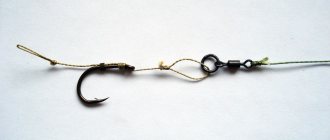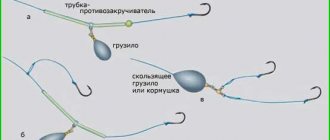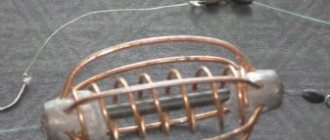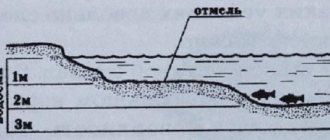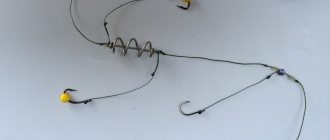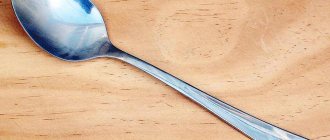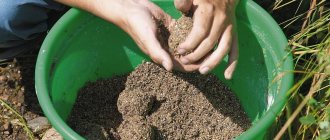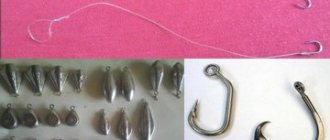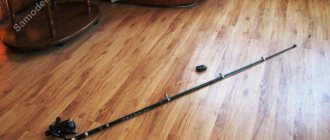Many people pay attention to the possibility of using a feeder when hunting for crucian carp. Do not forget that the feeder is a type of bottom tackle.
Initially it was improved in England; tackle can be made using a wide variety of materials. It is worth paying attention to the fact that it is also possible to create a feeder with your own hands, which will save you a lot of money.
Feeder design features
Today, the feeder is very common and is a well-known device designed for bottom fishing.
Among the features we note the following points:
- For feeder fishing, only suitable rods are used, which can be plug-in or telescopic. The different flexible tops allow you to use feeders of different weights. In specialized stores there are models with lengths from 1.8 to 4.5 meters. The length largely determines how far the cast can be cast.
- The reel can be any of the sold inertia-free versions, which have front and rear clutches. In order to count on a large catch, you should purchase a model with a baitrunner.
- Main line. The fact that fishing takes place at a significant distance from the shore determines the need to use braided fishing line. It does not stretch even after prolonged use and transmits the signal very accurately. In addition, the fishing line is characterized by increased mechanical stability.
- The feeder is an important part of the rod; it is selected depending on how far the cast will be cast. The shape of the structure does not matter.
- The leash is also an important part of the tackle. Monofilament fishing line is often used, as well as fluorocarbon. The second material is characterized by being less noticeable.
- Hooks. For carp fishing, only special products designed for significant mechanical impact are used.
- Rod stand. When feeder fishing, you should use a special device, so you don’t have to constantly hold it in your hands.
Let's celebrate! Such gear is characterized by fairly high efficiency in use.
Moreover, you can assemble it with your own hands.
"Crucian carp killer."
Equipment “Crucian carp killer”
This is a non-sporting rig, which is used when fishing with a classic donk and feeder tackle. It is believed that it was first made in England, but many disagree with this statement. As a rule, the equipment consists of several spring-type feeders located at a short distance of 10-15 cm, with both sliding and blind mounting, as well as a large number of hooks with short leads of 7-10 cm.
The peculiarity of such feeders is that they have a core tube through which the fishing line is passed. This greatly simplifies installation and also allows you to connect reliable and convenient equipment.
The number of feeders used for fishing is not particularly limited, but it is believed that the best option is to use 3 feeders.
When fishing with the “crucian carp killer” rig, it is very convenient to experiment with different types of baits, due to the use of a large number of leashes with hooks (usually there are six for three feeders). In fact, you can simultaneously use maggots, corn, boilies, peas, worms, bloodworms and other attractive baits.
Tips for a fisherman: What kind of hook is needed to catch crucian carp - Answers for beginners
Today, the “crucian carp killer” mount can be bought at any fishing store, and it is presented from many famous manufacturers. But it’s cheaper and more reliable to do it yourself, especially since it’s very simple.
Do-it-yourself “crucian carp killer” feeder rig.
To make effective feeder equipment for catching crucian carp, we will need:
- 3 spring-type feeders with a core tube;
- drop type sinker;
- stopper 8-10 pieces;
- swivel with clasp (carbine);
- swivel;
- 6 hooks;
- fishing line for leashes;
- fishing line for installation.
We make feeder equipment for catching crucian carp with our own hands.
- Let's take a fishing line that will form the basis of the installation, 50-60 cm long. This can be either a regular monofilament fishing line or a braided cord. We will attach a swivel with a carabiner to one end of the fishing line. I am not a supporter of using various additional elements in editing. But the use of a fastener in this installation allows you to conveniently change the sinker. This is especially important when fishing in the current, when you have to select the weight of the load.
- At a distance of 5 cm we knit a figure eight or double surgical knot so that the stopper does not slip;
- We place the stopper on the fishing line and move it towards the knot;
- We put one feeder on a fishing line through a core tube;
- If you are knitting a sliding installation (making your equipment more sensitive), then at a distance of 4 cm you need to tie a second knot. If blind installation is intended, then the knot must be tied as close to the feeder as possible;
- We start the stopper and take it to the knot;
- At a distance of 5 cm from the knot we knit a loop to attach the leash;
- We tie a knot at a distance of 5 cm from the loop and repeat the entire procedure from the very beginning;
- We tie a swivel to the end of the fishing line to connect it to the main fishing line or knit a loop;
- Now we need to tie several leashes of small length so that after attaching them to the loops during installation, they do not come into contact with the feeders;
Among the bait there must be a worm. Crucian carp loves fragrant baits, so it is better to stock up on dung worms. In addition to the smell attractive to fish, this type of worm is characterized by high mobility on the hook. In spring and late autumn, crucian carp shows interest in bloodworms. The fisherman should have maggots from spring to autumn.
DIY feeder tackle for crucian carp
Feeder gear can be made exclusively by using ready-made elements, the selection of which should be given quite a lot of attention. The main recommendations are as follows:
Rod selection
- When assembling feeder gear for crucian carp, some fishermen pay attention exclusively to budget options, which is a serious mistake. This approach becomes the reason for obtaining an ordinary donka.
- The feeder spinning rod is characterized by a special action, ¾ has increased rigidity.
- The tip should be elastic, which significantly increases the sensitivity of the gear.
- For fishing in small bodies of water, an option with a length of up to 3.3 m is suitable, the test is 30-50 grams.
- Long casting can be done using a rod that has a length of 3.6 to 3.9 meters.
- In this case, the recommended test value is 70-130 grams.
Leash and line
When feeder fishing, braided cord is often used. It is characterized by increased strength, while reducing the likelihood of stretching, which makes the tackle very sensitive.
In some cases, in addition to the cord, a special shock absorber is attached, the manufacture of which uses rubber. A braid with a cross section of 0.14-0.16 mm is suitable for carp.
A modern proposal is a monofilament line, which can be used in case of a large number of stones at the bottom. In such a case, the braid can quickly wear out.
Good to know! The leash used may also vary significantly. In manufacturing, a variety of materials are used that are designed for use in difficult conditions.
Feeder feeder
The feeder for the feeder equipment is characterized by a fairly large number of features:
- It is worth considering that if you cast incorrectly or have dead hooks, you can lose it.
- As a rule, the feeder is selected depending on the depth of the fishing spot, as well as the presence of a current. Almost all designs are suitable for a standing pond, but rectangular or triangular ones are suitable for a river.
- The dimensions of the structure are selected taking into account how much bait you need to throw at one time. At the beginning of fishing, as a rule, larger versions are used, since you need to create a large spot of bait. The weight is selected depending on the speed of the current and the required casting distance. For long distances, an option weighing from 35 to 45 grams is suitable; when fishing from a boat, an option weighing from 110 to 130 grams is suitable.
- In manufacturing, steel with increased corrosion resistance is often used, thereby increasing its service life.
Hook selection
The choice of a suitable hook depends on what kind of fish will be caught and what kind of bait is used. For example, bloodworms can only be put on a small thin or sharp hook. The worm can be put on a long forend.
Coil
The reel is selected depending on which spinning rod was previously selected. For a light feeder, it is recommended to choose the option with a 2000-3000 coil. There are also more powerful versions suitable for use in feeder fishing.
The information above indicates that the assembled feeder gear can have a variety of properties. That is why it is recommended to first determine the fishing conditions.
Feeder tackle: device, main elements
A feeder is essentially an improved fishing rod; it consists of the following parts:
[THERE IS AN ANSWER] How to catch a large crucian carp among small ones
- Rod. These devices differ from each other in terms of action, length and test. It all depends on what range it is designed for.
Action is understood as its ability to bend while pulling out prey and throwing bait. Based on this feature, bits can be divided into 3 groups:
- slow action, bending starts smoothly from the handle;
- medium, such devices bend faster starting from the middle;
- fast when only the end is bent.
By test we mean, in simple terms, the strength of the fishing rod. The coefficient is written in only 2 digits. The first means the smallest weight of the nozzle used when casting, the second means the maximum. These indicators are necessary to ensure that the rod does not suffer damage. Coil. An inertia-free reel is best suited for feeder tackle. It has a large margin of safety, thanks to this you can pull out even the largest fish.
The brake can be rear or front. This will be convenient for the fisherman.
- Fishing line. The choice of fishing line is an important issue. Here you need to take into account what kind of fish will be caught and under what conditions. Based on this, the color, thickness, and strength of the fishing line are already determined. For the feeder, braid with a diameter of 0.1 - 0.12 mm is best suited.
- Hook. The hook is selected based on the color and size of the bait. Do not forget that it must also correspond to the size of the fish.
Since crucian carp mainly prefers to look for food in silted areas, it would be useful to prepare feeders. The lighter the silt, the greater the likelihood of catching a large crucian carp, and a feeder buried in the silt attracts fish much less than one located on the surface of the ground.
Catching crucian carp on a feeder with a feeder
Since crucian carp mainly prefers to look for food in silted areas, it would be useful to prepare feeders. The lighter the silt, the greater the likelihood of catching a large crucian carp, and a feeder buried in the silt attracts fish much less than one located on the surface of the ground.A properly adjusted feeder flies far and at the same time, sinking to the bottom, does not bury itself in the silt. Polystyrene can be painted with waterproof markers either to match the color of the bottom, or (when using bright bait) to match the color of the bait.
For example, you can prepare boiled barley, corn, wheat, maggots, dung worms, regular dough, or just boiled potatoes.
With the arrival of summer, feeder gear is considered the best option for catching crucian carp. Because the fish begins to migrate from the coastal zone to the depths and into the pits. And not every spinning rod can cope with the task of getting to the crucian carp’s camp site.
At this time of year, you can use different baits at your discretion.
And as bait you should pay attention to the following:
- steamed pearl barley porridge;
- regular dough;
- semolina;
- maggot;
- muckworm.
corn;
To ensure long casting, it is recommended to choose feeders weighing no more than 80 g.
Good luck catching crucian carp on the feeder! Now you don’t have to be afraid of anything, luck is on your side, and knowledge about the peculiarities of such fishing will only help you with this.
Installation of feeder on crucian carp
There are quite a large number of different feeders, which are characterized by their specific operational characteristics.
More widespread:
- Crucian carp killer. This tackle should be tried out by all bottom fishing enthusiasts. This is due to the fact that the result is very high.
- Gardner's loop. It has become very widespread not only in feeder fishing. As a rule, it is used for fishing with bottom gear.
- Asymmetrical loop. It is created when using a certain leash. It is worth considering that careful biting is only possible with a long product length.
- In-line. This version is not widely used in comparison with the previous one. With enough experience, it also allows you to count on a good catch.
The selection of suitable equipment depends on the specific fishing conditions.
Features of catching crucian carp on a feeder
Fishing begins with choosing the most suitable place. If it’s your first time on a pond, you have to probe the bottom.
This is done in three main ways:
- Jig probing.
- Using marker cloth.
- Using a shore echo sounder.
Let's celebrate! It is recommended to choose a flat area of the bottom, often called a table. The depth of the site must be at least 2 meters. In many ways, the fishing location depends on the bait chosen.
Choosing feeder equipment for catching crucian carp in various conditions
For catching crucian carp using a feeder, the choice of feeder equipment depends on the fishing conditions. The length and power of the fishing rod, the thickness and color of the fishing line, the structure of the reel and the method of rigging the fishing rod depend on many external factors.
Feeder rig for crucian carp in still water
Fishing with a feeder in still water is great for fishermen who are mastering this method. The advantage of using this gear in a reservoir where there is no current is that the position of the bait with the nozzle remains unchanged during fishing, and there is also no washout of the bait.
For effective fishing for crucian carp with a feeder in reservoirs where there is no current, areas with differences in depth are most relevant. In these places, crucian carp can feed throughout the daylight hours.
Areas of the reservoir next to a tree that has fallen into the water are excellent for feeder fishing, but you need to be careful when fishing in snags ; the feeder can easily get caught among underwater snags and branches.
Large catches of crucian carp on a feeder can be obtained if you use loop rigs; they are ideal for such fishing conditions.
To catch crucian carp in ponds and lakes, you can use plastic lightweight feeders. In this case, additional loading of the gear is not required due to the lack of current.
Lures and groundbaits for catching crucian carp
Crucian carp requires special bait.
There are two types:
- The purchased mixture is found in specialized stores. Often, only when using them can you count on a large catch, since special materials are used in their manufacture that provide increased odour. This is why the bait works much faster.
- Many experienced fishermen prepare the mixture themselves. It is much cheaper, but may be less effective.
Recently, they have been combining purchased and homemade bait. Due to this, costs can be significantly reduced.
Advantages and disadvantages of feeder gear
The fishing technology in question has many advantages and disadvantages that must be taken into account.
The advantages include the following:
- Fast and easy learning.
- Even when fishing for the first time without experience, you can count on a good catch.
- High degree of versatility.
- Easy to install.
- In some cases, you can fish without measuring depth.
- Less need for bait.
- The bait holds even in strong currents.
- Fishing is possible at great distances.
- When fishing from the bottom, you can count on fairly large specimens.
However, there are several significant disadvantages:
- Fishing difficulties arise above the bottom.
- When casting, a lot of noise is created.
- It is possible to determine the casting location only if you have the appropriate experience.
- When casting far away, the sensitivity of the rod used is significantly reduced.
Let's celebrate! All ardent hunters of the prey in question should try this type of gear, as it allows them to count on a good and consistent catch.
How to equip a feeder rod with a reel and equipment
Coil
To equip the feeder, specially produced reels are used, but if one is not found, a regular spinning reel will do. Below are the recommended parameters that your reel should have:
Tips for fisherman: How to catch crucian carp in the spring with a float rod - Features of choice
Reels are divided into high-speed and power types, according to gear ratios. We need something in between. A reel with a gear ratio up to 4.6 is a power reel, and a reel with a gear ratio above 5.5 is a high-speed one. Reels with gear ratios ranging from 4.6 to 5.5 are just right for us.
Let's move on to the bobbin. Usually the universal size is 3000. For us, from 2500 to 4000 is suitable. By the way, when choosing a reel, inquire about the presence of a spare spool in the kit; if it is not there, ask which models are on sale separately and buy it, believe me, it will come in handy.
When fishing with a feeder, the probability of a sharp jerk is very high, and, accordingly, the line will break. We don’t need this, so we make sure that our reel is equipped with a friction brake. The clutches are front and rear. The rear clutch is less sensitive and is easier to use in feeder fishing, while the front clutch is more often installed on spinning reels. There is not much difference - who is more comfortable working with what.
The reels use ball bearings, some models can have up to fifteen of them. There is no need to chase quantity - those with 5-6 bearings are quite suitable for us, but no less, because the device has at least 5 elements that are very susceptible to abrasion.
We can recommend the following models:
- Shimano BAITRUNNER 4000 D up to 5000 rub.
- Okuma LONGBOW BAITFEEDER 50 to 2000 rub.
Okuma LONGBOW BAITFEEDER 50 with baitrunner - budget quality reel
Let's move on to the issue of choosing fishing line
The debate about which is better - monofilament or braided line - still continues. Let's look at the advantages and disadvantages:
If you haven’t decided on your own which fishing line to choose, take monofilament if you don’t catch crucian carp. Braid is still better for him because of his very weak touch to the bait. Choose a monofilament line with the lowest stretch and preferably a dark color (this is used by carp fishermen for good reason, it is not visible at the bottom).
For leashes, use high-quality fluorocarbon fishing line that is invisible in the water.
Equipment is the heart of the feeder
The simplest equipment with which to start studying a feeder is a paternoster. It consists of a loop into which the feeder is threaded and a leash on which the hook is attached.
The equipment is made as follows:
- We take the main fishing line and tie a loop for the leash at the tip.
- Next, place your palm along the length of the first loop and knit a second loop at the end of the palm. The size of the second loop should be such that the feeder fits into it.
- We attach the feeder - we pull a large loop through the swivel and throw it on the feeder itself. We fix the line on the swivel itself. Using the “loop-to-loop” knitting method, we attach a leash with a hook to the second small loop.
- "Paternoster" is ready.
Video for clarity:
Now let's talk about feeder rigs for catching bream in the current, carp and crucian carp.
Another key point when fishing with a feeder is also related to bait. Despite a good starting feeding, crucian carp always respond well to a feeder that sinks to the bottom and spreads an attractive bait. Therefore, to further attract fish to it, after placing the rod in the stand, turn the reel handle. Thus, the feeder lying on the bottom will move slightly, creating a favorite mud for crucian carp from silt and food.
Reviews from fishermen
I’ve been fishing for crucian carp with similar gear for a long time. It performs well, the main thing is to choose the right bait. Grade:
Dmitriy
I made my own feeder tackle, and as soon as I got used to it, my catch increased significantly. Grade:
Vitaly
I’ll say right away that with such tackle you need to use special bait. Due to this, the catch increases significantly. Grade:
Gregory
I was on the lake with a friend, he showed feeder gear in use. I liked the result. Grade:
Maksim
I used to go to the river with a regular float, but after I tried the feeder I realized that there was practically no tackle for him, the catch was very good, and the fish were large. Grade:
Anton
Note! As a rule, there are no serious problems with collecting feeder gear. However, a large number of different elements determines a significant increase in the cost of the product.
